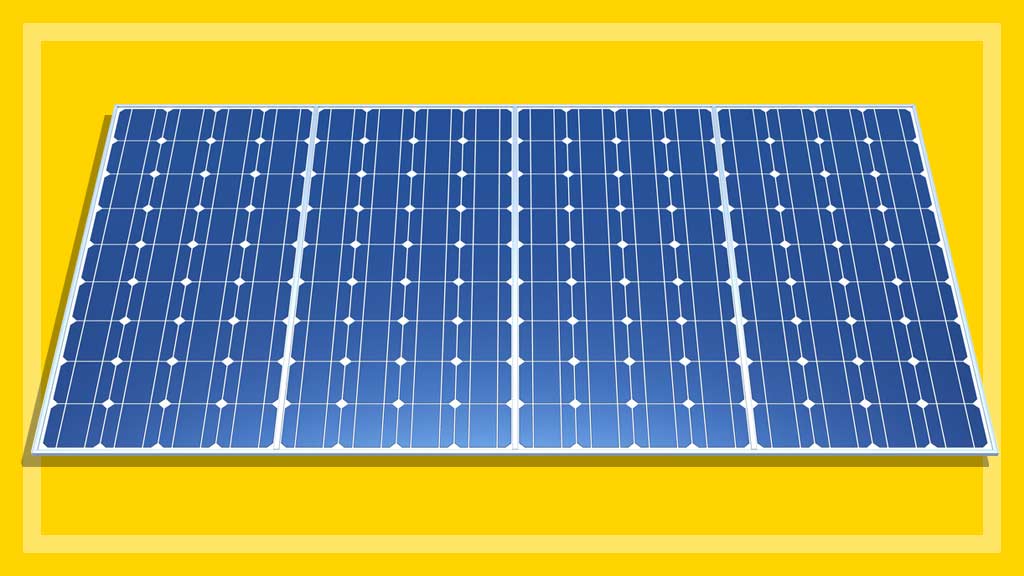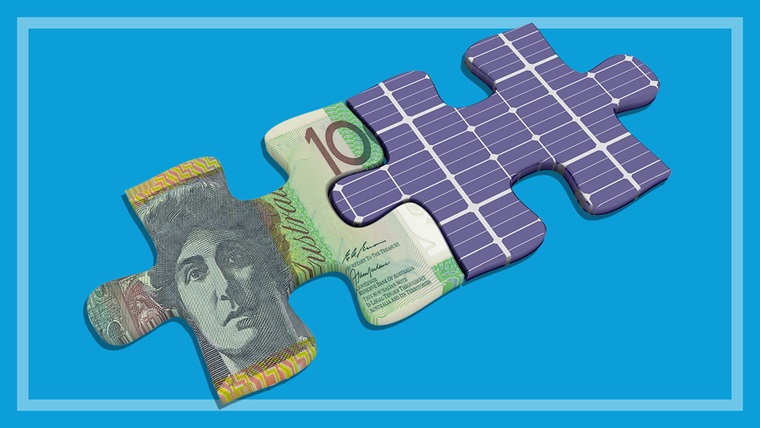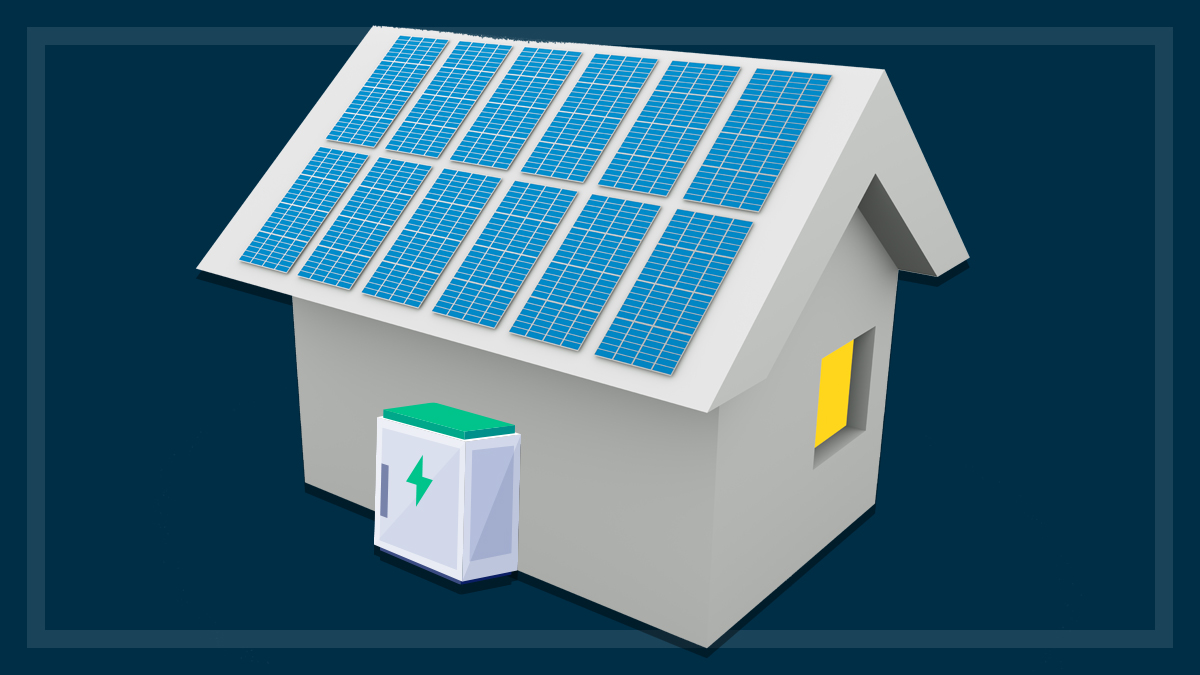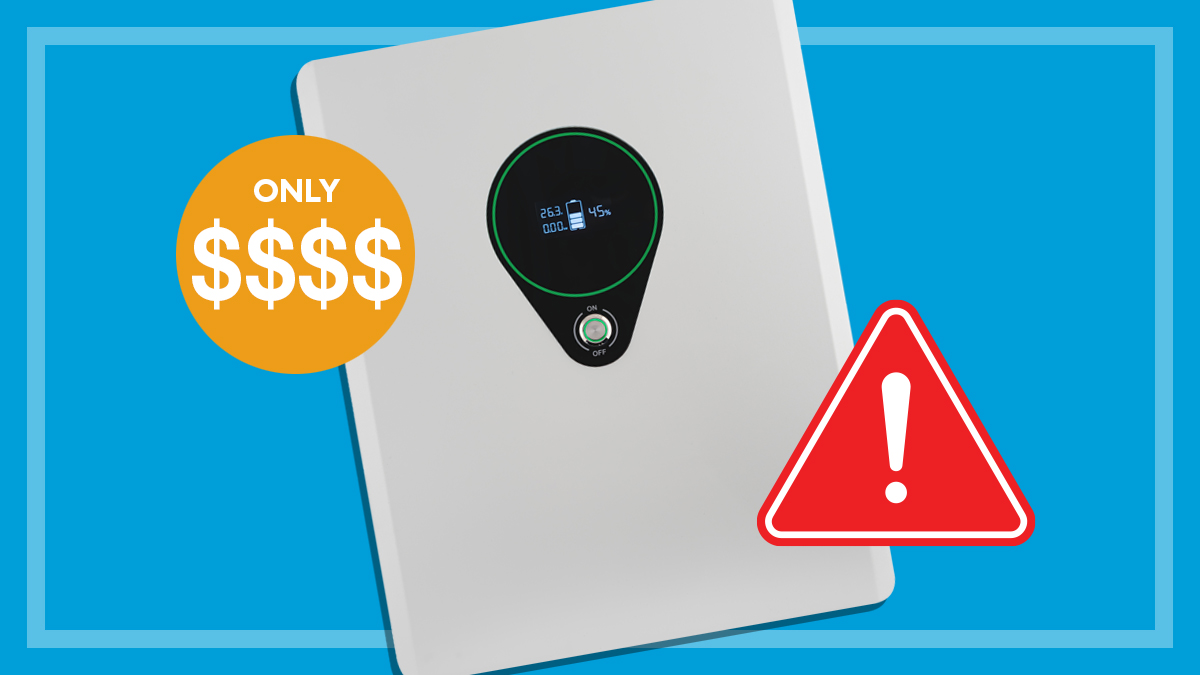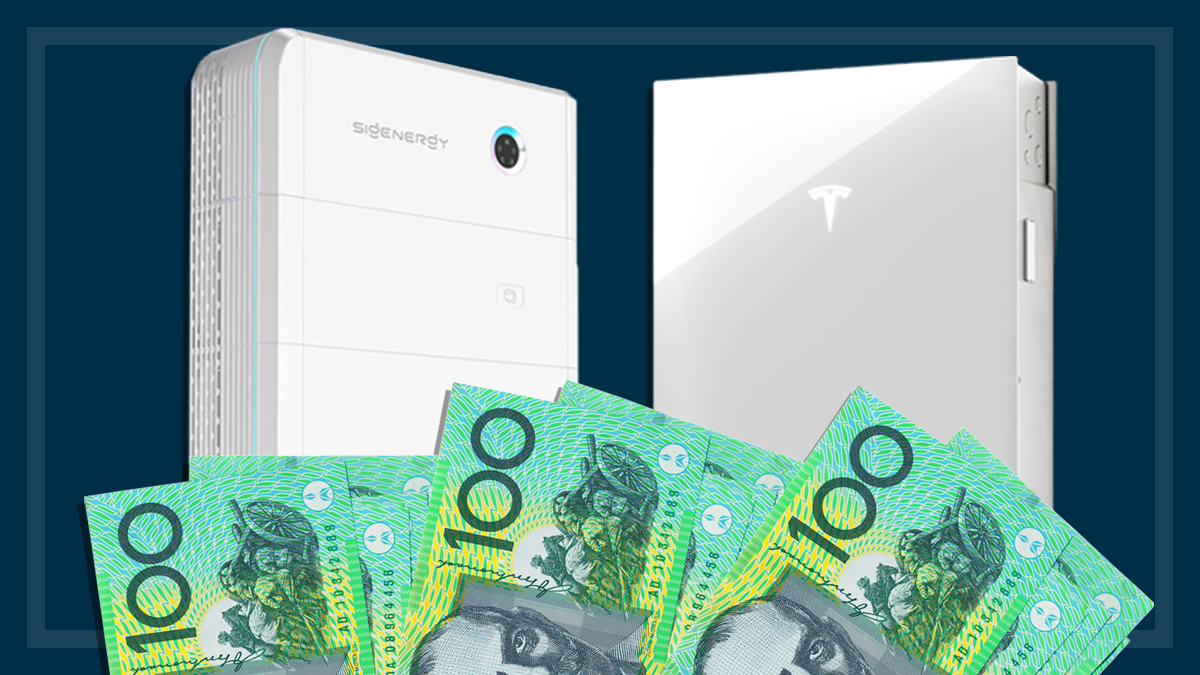Get our independent lab tests, expert reviews and honest advice.
How to buy the best home solar battery storage system
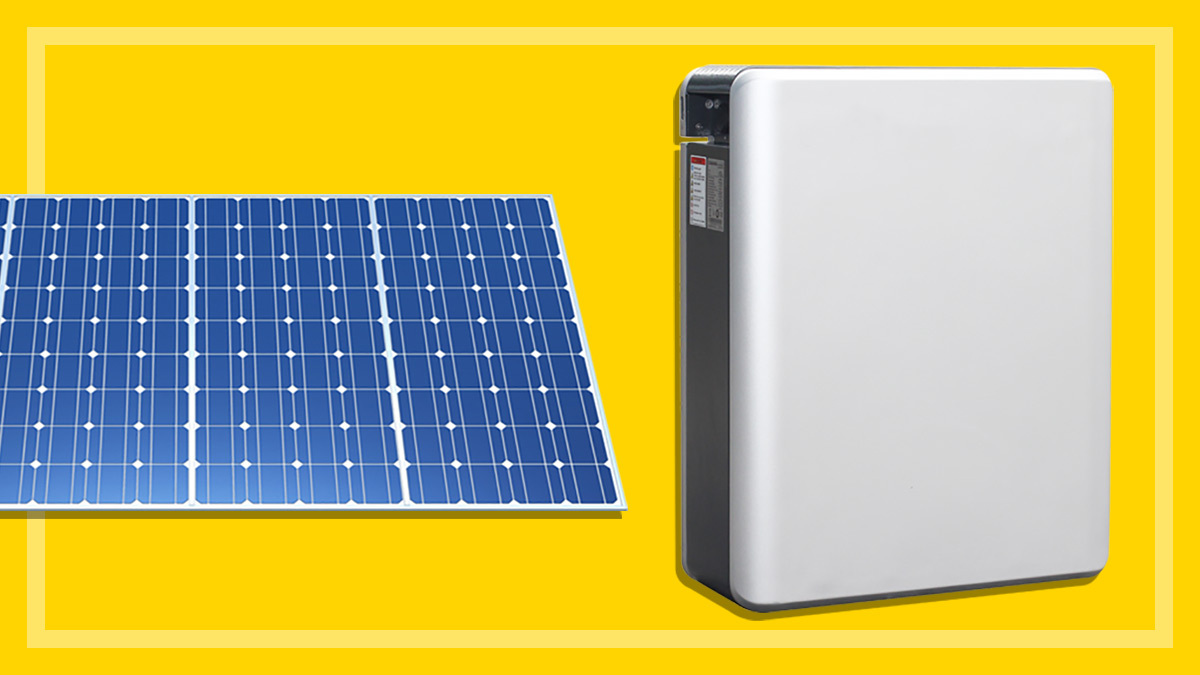
Home battery storage is a hot topic for energy-conscious consumers. If you have solar panels on your roof, there’s an obvious benefit to storing any unused electricity in a battery to use at night or on low-sunlight days.
On this page:
- How do home solar batteries work?
- How much does a home solar battery cost?
- Are home batteries a worthwhile investment?
- Savings and payback times
- Battery savings calculator
- Rebates and subsidies
- Virtual Power Plants
- What happens in a blackout?
- How long do solar batteries last?
With the launch of the federal government’s $2.3 billion Cheaper Home Batteries Program in July 2025, interest has gotten even hotter. Commonly known as the solar or home battery rebate, this new incentive offers around 30% off the total cost of installing a battery in eligible homes and small businesses. Read our in-depth guide to the rebate conditions, battery prices and payback times.
With a flood of rebate-related promotions now out in the market (and the potential risk of dodgy installers), it’s even more vital to understand battery costs and types, your own power needs and how long a battery can take to pay for itself. This expert buying guide plugs into all that and more.
Urgent battery recalls
Tesla Powerwall 2: Certain battery cells in some Powerwall 2 systems may fail and overheat, causing smoke or flames. Most affected units have been remotely discharged by Tesla. Consumers should check if their system is online and Tesla App for notifications. Affected units will be replaced at no cost.
LG: Some batteries may overheat and catch fire, and need to be shut down immediately. These have also been sold as rebranded batteries under brand names including SolaX, Opal, Redback, Red Earth, Eguana and VARTA.
If you have these, urgently check the ACCC’s Product Safety website.
How do home solar batteries work?
The concept of home battery storage isn’t new. Off-grid solar photovoltaic (PV) and wind electricity generation on remote properties has long used battery storage to capture the unused electricity for later use.
Storage batteries are increasingly popular with new solar installations, and it’s possible that within the next five to 10 years, most homes with solar panels will have a battery system.
If your solar panel array and battery are large enough, you can run your home substantially on solar power
A battery captures any unused solar power generated during the day for later use at night and on low-sunlight days. Installations that include batteries are increasingly popular. There’s a real attraction to being as independent as possible from the grid – for most people it’s not just an economic decision, but also an environmental one, and for some it’s an expression of their wish to be independent of energy companies.
If your solar panel array and battery are large enough, you can run your home substantially on solar power. Using electricity from your battery can be cheaper per kilowatt-hour (see Terminology) than using electricity from the grid, depending on the time of day and electricity tariffs in your area.
How much does a home solar battery cost?
Costs vary significantly for solar home batteries, but generally, the higher the battery capacity, the more you can expect to pay.
Since the launch of the federal rebate, the ‘average’ size of batteries being installed has increased dramatically, with a system closer to 20kWh quickly becoming the new norm.
Here are typical battery costs after the federal rebate for common sizes, including basic installation. Prices are based on information from SolarQuotes.
- 10 kWh storage: $7,000-$11,000 installed
- 15 kWh storage: $11,000-$15,000 installed
- 20 kWh storage: $14,000-$19,000 installed
- 30 kWh storage: $18,000-$22,000 installed
Keep in mind, a more complicated installation will bump up costs considerably, given architectural and technical factors can increase the time, work and components a job requires.
Most households are likely to benefit from a battery with a decent amount of capacity, about 10kWh or more. But a smaller battery can be sufficient for small households with low energy usage.
As an example, one of the most popular batteries is the 13.5kWh Tesla Powerwall 3. This currently costs about $11,000 installed after the federal rebate.
The lower-end prices tend to be for a battery pack only (cells plus battery management system). Higher-end prices often mean that the battery system has a built-in battery inverter and other integrated components as well. When getting quotes, make sure it’s clear whether the cost of a new inverter and extra electrical work are factored in.
It can be more cost-effective to buy a battery as part of an entire new solar panel system package than to retrofit it to an existing system, especially if it’s several years old.
It may need substantial upgrading to accommodate the battery; for example, older systems are often relatively small, say 3-5kW, and may need more panels added to deliver enough power for charging the battery and powering the home.
Why we've partnered with SolarQuotes
We've partnered with SolarQuotes to help you find and buy the right solar, battery, heat pump and EV charger. While we make money if you use SolarQuotes to find an installer, this doesn't influence our ratings. 100% of the money we make goes directly back into our nonprofit mission.
Grid-connected vs off-grid
There are four main ways your home can be set up for electricity supply.
Grid-connected (no solar)
The most basic set-up, where all your electricity comes from the main grid. The home has no solar panels or battery.
Grid-connected solar (no battery)
The most typical set-up for homes with solar panels. The solar panels supply power during the day, and the home generally uses this power first, resorting to grid power for any extra electricity needed on low-sunlight days, at night, and at times of high power usage.
Grid-connected solar + battery (aka ‘hybrid’ systems)
These have solar panels, a battery, a hybrid inverter (or possibly multiple inverters), plus a connection to the main electricity grid. The solar panels supply power during the day, and the home generally uses the solar power first, using any excess to charge the battery. At times of high power usage, or at night and on low-sunlight days, the home draws power from the battery, and as a last resort from the grid.
For more on different types of inverters, how they work and their pros and cons, check out our guide to buying a solar inverter.
Off-grid
This system has no connection to the main electricity grid. All the home’s power comes from solar panels, and possibly some other types of power generation as well, such as wind. The battery is the main power source at night and on low-sunlight days. The final back-up is usually a diesel-powered generator, which may also kick in when there’s a sudden high demand for power (such as when a pump starts up).
Off-grid systems are usually much more complex and expensive than grid-connected systems. They need more solar and battery capacity than a typical grid-connected system and may also need inverters capable of higher loads to cope with peak demands. Homes that run off-grid need to be particularly energy-efficient and the load demand needs to be well-managed throughout the day.
Off-grid systems generally only make sense for remote properties where a grid connection isn’t available or would be prohibitively expensive to install.
Are home batteries a worthwhile investment?
It’s a complicated question and one that depends on multiple factors including your solar/battery set-up, energy consumption and electricity costs in your state or territory, which can vary wildly.
For a long time, home batteries didn’t make complete economic sense. They were relatively expensive and the payback time was often longer than the battery’s warranty period which is typically 10 years.
With the new federal rebate promising an approximate discount of 30%, that equation is looking a lot more favourable, depending on the aforementioned factors.
Savings and payback times
Calculating your own maths can be mind-boggling, but thankfully our solar partners SolarQuotes have shared this helpful guide comparing electricity savings and simple payback periods (how long it takes your bill savings to pay off battery cost) by state and territory.
You’ll notice below that payback times vary a lot depending on where you live. That’s due to your state and territory’s electricity prices, feed-in tariffs and weather.
For example, Adelaide’s payback period is the shortest because they have high electricity prices, while Hobart’s is the longest, thanks to relatively cheap electricity and high solar feed-in tariffs.
| Capital city | Annual Electricity Savings | Simple Payback Period |
|---|---|---|
| Adelaide | $1,350 | 6.3 years |
| Brisbane | $1,100 | 7.7 years |
| Canberra | $700 | 12.1 years |
| Darwin | $620 | 13.7 years |
| Hobart | $410 | 20.7 years |
| Melbourne | $610 | 13.9 years |
| Perth | $1,120 | 7.6 years |
| Sydney | $1,030 | 8.3 years |
Why install a storage battery?
Simple economics – i.e. saving money – is the main motivation for most people. Households with high power consumption that are savvy about using their solar-generated and stored power can make the battery pay for itself in less than 10 years.
Additionally, joining a Virtual Power Plant (VPP) scheme can improve the economics too (see below for more on VPPs).
But for many people investing in home batteries, the motivation isn’t just about economics. Protection against blackouts, environmental concerns about fossil fuels, energy independence from the grid, and even simply liking this new technology are all perfectly good reasons to consider a battery.
We recommend getting two or three quotes from reputable installers before committing to a battery installation. The results of an independent trial of storage batteries show that you need a strong warranty, and commitment of support from your supplier and battery manufacturer in the event of any faults.
Battery savings calculator
SolarQuotes has a battery calculator to help you figure out the savings you might make from adding a storage battery to your existing solar panel system.
To use it, you’ll first need to obtain a NEM12 file from your electricity distributor; this is the data collected by your smart meter, which shows in detail how much energy your solar panels generate, how much electricity your home uses at different times of the day (night-time power consumption is a key factor here), and therefore how much would be available to charge a battery. Here’s their guide to how you obtain this file. Request 12 months of data, so that you have a full picture of your solar usage in every season.
If you don’t have solar at all, and are wondering if you should buy a system with battery included, the CHOICE Solar Estimator is a quick and easy way to look at the potential savings with and without a battery.
Rebates and subsidies
Government rebate schemes, and energy trading systems such as Reposit, can definitely make batteries economically viable for some households.
Federal battery rebate
Launched in July 2025, the federal government’s Cheaper Home Batteries Program gives homeowners, small businesses, and community groups an upfront discount of around 30% on the purchase and installation of a home battery system that pairs with solar panels.
The rebate is based on the battery’s usable capacity, up to 50 kWh, with a maximum saving of $372 per usable kWh. Once you deduct admin charges, it’s more like $330 per usable kWh, so a typical 10 kWh battery would see a handy $3,300 discount applied to your quote upfront.
Just like the solar panel rebate, the rebate decreases every year and is currently set to end in 2030.
To be eligible for the rebate, the battery must:
- Be installed on or after 1 July 2025
- Have a nominal capacity of 5–100 kWh, with the rebate applied to the first 50 kWh of usable capacity
- Be installed alongside new or existing rooftop solar
- Be on the Clean Energy Council (CEC) approved list
- Be fitted by an installer accredited by Solar Accreditation Australia
- For on-grid systems, be capable of joining a Virtual Power Plant (VPP), though actual participation is optional
Note that the federal government’s Small-scale Technology Certificate (STC) financial incentive for solar panel systems (the “solar rebate”) only applies to the solar panels in the installed system, not the battery.
State and territory rebates and incentives
In addition to the federal initiative, here are the current battery-focused rebates or loan schemes available by state and territory. These can be combined with the federal rebate for greater savings.
ACT: Sustainable Household Scheme
NSW: Virtual Power Plant Incentive
Northern Territory: Home and Business Battery Scheme
Victoria: Solar Homes Program
Note: Victoria has a fixed number of subsidies available over a set period so it’s possible for it to be active, but unavailable until the next round of subsidies opens up.
WA: Residential Battery Scheme
Terms and conditions apply to all of them so you need to do your homework to ensure you’re eligible. Also, rebate schemes are revised from time to time, so it’s worth also checking the federal government energy website to see what’s available in your area.
Virtual Power Plants
A Virtual Power Plant (VPP) is a network of solar and battery systems installed on homes and businesses, centrally controlled by a computer system run by the VPP operator company. By joining a VPP program, you agree to make the stored energy in your home battery available to the VPP operator who can then use it to supply the grid in times of high demand.
In return, you’re paid a subsidy, which might be in the form of reduced energy bills, a rebate towards buying the battery, or even free solar and battery installation. But note that even joining a VPP program won’t always guarantee that your battery pays for itself, and it can mean that you’ll sometimes find your own battery is running low at night when you want it, due to the VPP having taken some of the stored energy earlier that day.
There are various Virtual Power Plant programs in most states which can help reduce the cost of a battery. SolarQuotes maintains a list of current VPP programs.
Playing the electricity market
Some electricity retailers such as Amber offer plans that price your electricity in 15 minute intervals, based on the wholesale market price at that moment in time. This price can vary wildly, from extremely expensive to buy (but great to sell your excess solar or stored battery energy at that moment), to negative pricing (when you’ll actually be paid for using grid energy, but might have to pay the retailer for any solar power you export; so that’s a great time to charge your battery with solar or grid power).
These plans can be very effective, even profitable, if you are prepared to monitor prices daily and adjust your home energy usage accordingly. But if you’d rather just “set and forget” your electricity plan and not worry too much about when you run your appliances, this type of plan could end up costing you more.
Don’t forget the feed-in tariff
When you’re doing the sums to decide whether a battery makes sense for your home, remember to consider the feed-in tariff (FiT). This is the amount you’re paid for any excess power generated by your solar panels and fed into the grid.
For every kWh diverted instead into charging your battery, you’ll forgo the feed-in tariff. While the FiT is generally quite low in most parts of Australia, it’s still an opportunity cost you should consider. If you still have a generous FiT (30c/kWh or more), it could be more profitable to not install a battery and just collect the FiT for your surplus power generation. However, any system still on those rates is probably an older, small capacity system, and it may be better in the long run to upgrade it to a new, larger capacity system.
Home insurance
Your solar panel system (panels, inverter, and battery if you have one) is part of your house, and as such it’s covered by your home insurance. However, you should make sure your home’s insured amount is increased to cover the replacement cost of the solar panel system. Check out our guide to solar panels and home insurance for more info.
What happens in a blackout?
For most grid-connected systems, having a battery doesn’t necessarily protect you in the event of a blackout. You may still lose all power to your home, despite having solar panels producing power and a charged battery ready and waiting.
This is because grid-connected systems have what’s known as ‘anti-islanding protection’. During a blackout, the grid and any engineers working on the lines must be protected from ‘islands’ of electricity generation (such as your solar panels) pumping power unexpectedly into the lines.
You may still lose all power to your home, despite having solar panels producing power and a charged battery ready and waiting
For most solar PV systems, the simplest way to provide anti-islanding protection is to shut down entirely. So, when it senses a grid blackout, your solar PV system shuts down and you have no household power at all.
More sophisticated inverters can provide anti-islanding protection during a blackout, but still keep the solar panels and battery operating so that the house has some power. But expect to pay a fair bit more for such a system, as the hardware is more expensive and you may need more solar and battery capacity than you think to run the house for a few hours during a blackout.
You should probably choose to allow only critical household circuits to operate in that situation, such as the fridge and lighting (and that might require extra wiring work). A storage battery is likely to be drained very quickly if it also has to run things such as a pool pump or underfloor heating, which can draw a lot of power.
Types of solar battery
Lithium-ion
The most common type of battery being installed in homes today, lithium-ion batteries use similar technology to their smaller counterparts in smartphones and laptop computers. There are several types of lithium-ion chemistry. A common type used in home batteries is lithium nickel-manganese-cobalt (NMC), used by Tesla and LG Chem.
Another common chemistry is lithium iron phosphate (LiFePO, or LFP) which is said to be safer than NMC due to lower risk of thermal runaway (battery damage and potential fire caused by overheating or overcharging) but has lower energy density. LFP is used in home batteries made by BYD and Sonnen, among others.
Pros
- They can give several thousand charge-discharge cycles.
- They can be discharged heavily (to 80–90% of their overall capacity).
- They’re suitable for a wide range of ambient temperatures.
- They should last for 10+ years in normal use.
Cons
- End of life may be a problem for large lithium batteries.
- Fires and thermal runaway are fortunately very rare in these home storage batteries, but can be severe if they do happen. For safety, lithium batteries must be installed only in certain locations; typically outdoors (usually near the solar inverter) or in a garage.
- They need to be recycled to recover valuable metals and prevent toxic landfill, but large-scale programs are still in their infancy. As home and automotive lithium batteries become more common, it’s expected that recycling processes will improve.
Lead-acid, advanced lead-acid (lead carbon)
The good old lead-acid battery technology that helps start your car can be also used for larger-scale storage. It’s a well-understood and effective battery type, and banks of these batteries can be (and are) used for home storage batteries. But attempts to develop advanced lead-acid technology over the past several years have not delivered sufficient results, and this technology is fading away as a storage solution as lithium storage batteries have more advantages. It’s extremely unlikely that you’ll be offered a lead-acid battery these days.
Pros
- They’re relatively cheap, with established disposal and recycling processes.
Cons
- They’re bulky and require a lot more space than an equivalent lithium battery.
- They’re sensitive to high ambient temperatures, which can shorten their lifespan.
- They have a slow charge cycle.
- They require regular maintenance.
- Lithium batteries offer advantages such as relatively compact size, low maintenance and longer warranties.
Flow battery
One of the most promising alternatives to lithium-ion, this type uses a pumped electrolyte (such as zinc bromide or vanadium ions) and chemical reactions to store charge and release it again.
Redflow was the main flow battery brand in Australia, but unfortunately many customers reported failures with their batteries and the company went into administration in 2024.
Pros
- They can be discharged to 100% of their capacity and have no residual discharge so they won’t lose charge over time.
- They don’t lose capacity over time.
- They operate well in high ambient temperatures.
- They’re relatively easy to recycle.
- They should last for 10+ years.
- No fire risk.
Cons
- They’re relatively expensive compared to lithium-ion.
- They don’t tolerate cold well (below 15°C).
- They require frequent maintenance which takes them temporarily out of service.
Other types
Battery and storage technology is in a state of rapid development. Other technologies currently available include hybrid ion (salt water) batteries, molten salt batteries, and graphene supercapacitors. None of these are in common usage at this stage.
Battery specifications
These are the key technical specifications for a home battery.
Capacity
How much energy the battery can store, usually measured in kilowatt-hours (kWh). The nominal capacity is the total amount of energy the battery can hold, while the usable capacity is how much of that can actually be used, after the depth of discharge is factored in.
Depth of discharge (DoD)
Expressed as a percentage, this is the amount of energy that can be safely used without accelerating battery degradation. Most battery types need to hold some charge at all times to avoid damage. Lithium batteries can be safely discharged to about 80–90% of their nominal capacity. Lead-acid batteries can typically by discharged to about 50–60%, while flow batteries can be discharged 100%.
Power
How much power (in kilowatts) the battery can deliver. The maximum/peak power is the most that the battery can deliver at any given moment, but this burst of power can usually only be sustained for short periods. Continuous power is the amount of power delivered while the battery has enough charge.
Efficiency
For every kWh of charge put in, how much the battery will actually store and put out again. There’s always some loss, but a lithium battery should usually be more than 90% efficient.
Total number of charge/discharge cycles
Also called the cycle life, this is how many cycles of charge and discharge the battery can perform before it reaches the end of its life. Different manufacturers might rate this in different ways. Lithium batteries can typically run for several thousand cycles.
Lifespan (years or cycles)
The expected life of the battery (and its warranty) can be rated in cycles (see above) or years (which is generally an estimate based on the expected typical usage of the battery). The lifespan should also state the expected level of capacity at the end of life. For lithium batteries, this will usually be about 60–80% of the original capacity.
Ambient temperature range
Batteries are sensitive to temperature and need to operate within a certain range. They can degrade or shut down in very hot or cold environments.
How long do solar batteries last?
In principle, most solar battery types should be able to last 10 years or more under normal usage and if not subjected to extreme temperatures. That is, they should be able to last at least as long as their warranty period, which for most models is 10 years.
However, there isn’t enough market data to show whether modern solar batteries typically last that long in real-world home installations – recent generations of batteries have only been around for a few years.
Most solar batteries should be able to last 10 years or more under normal usage and if not subjected to extreme temperatures
Lab testing of battery durability and lifespan has not been encouraging. A solar battery trial in Australia found a high rate of failure, with very few of the batteries in that trial operating without any major problems. Most of them either had operational problems the manufacturer had to step in to resolve, or failed and needed to be replaced, or failed and couldn’t be replaced (for example because the manufacturer was out of business or would no longer support that product).
That said, several batteries from major brands performed well, or at least had good manufacturer support when problems occurred.
But consumer reviews on a variety of websites suggest that most households with storage batteries are happy with them so far, especially with the major brands. Some customers report problems with battery failure or with customer support from the supplier, but in most cases it appears that the batteries are performing as expected.
Future changes to the electricity market
The electricity grid in Australia wasn’t originally designed to cope with large numbers of homes exporting solar power into it. There are proposals for how to modernise the grid and manage it more effectively and fairly, and these include a possible surcharge – or ‘solar tax’ – to owners of solar PV systems who want to sell their excess power to the grid. What’s this all about, and does it mean a storage battery becomes a better option?
What’s the problem with the electricity grid?
The electricity grid in Australia was originally built with the expectation that electricity went in one direction only: from power stations to homes and businesses. It wasn’t designed to also allow for solar-generated power to flow back the other way. While that’s been possible to a reasonable extent so far, the grid is starting to hit the limits of how much electricity it can handle from domestic rooftop solar.
The grid needs a lot of work to update it to become flexible enough to take full advantage of renewable energy sources, including domestic solar feed-in, but also to allow flexibility for all consumers. This work has to be paid for somehow. Currently, some consumers (renters, apartment owners, low-income households) have little access to the benefits of solar power but must still pay for electricity, and to some extent they subsidise the benefits that solar owners obtain.
Solar owners are also disadvantaged by the lack of flexibility and modernisation of the grid, in that in some areas, there’s already limited or zero feed-in due to capacity constraints on the local grid. This means that some solar owners get limited or no feed-in tariff income, and their excess solar-generated electricity may be wasted.
What’s the solution?
The Australian Energy Market Commission (AEMC) has proposed several changes to how the market and the grid operate to allow more flexibility in how power is bought and sold, and to better accommodate domestic solar, batteries and electric cars in future.
- New electricity infrastructure (‘poles and wires’) will still be needed, but we also need to use the electricity supply in a much smarter way – and rebuilding the grid so that it properly accommodates solar-generated electricity from homes is part of the solution.
- The proposal includes the option of a surcharge to solar PV system owners who export power to the grid (the so-called ‘solar tax’).
- The AEMC expects that the proposed surcharge for solar owners will only have a small effect on their overall return from feed-in tariffs (FiTs). For example, a consumer with a 6–8kW solar panel system is expected to see their typical return from FiTs drop at worst by $106, from $1284 per year to $1178 per year. For most solar owners the impact will be less than that, and possibly even a net increase in returns if they’re able to time their solar export to deliver excess energy when the grid needs it, such as late afternoon or evening (when energy retailers are likely to offer a better FiT to attract more exported power). The AEMC has published an explanation of the proposals and modelling.
- This situation may also make storage batteries more economically attractive. If FiTs end up as low as a few cents per kWh during the middle of the day, but increase to much better rates in the late afternoon and early evening when demand on the grid is highest, it may make sense to store your excess power in a battery and sell it back to the energy retailer in the evening.
- It will also make sense (even more than it does now) to use as much of your own solar power as possible, as that will reduce any surcharge for exporting power to the grid.
When is all this going to happen?
The roll-out of the new charges and rewards is at this stage still a proposal and won’t take effect for a few years, and there will be trial programs and consultations along the way. This is not to say all will be perfect – we need to keep watch and make sure the new system truly is fair and reasonable.
But in short, there’s no need to panic, and it still makes sense to consider investing in solar power for your home right now.
Terminology
Watt (W) and kilowatt (kW)
A unit used to quantify the rate of energy transfer. One kilowatt = 1000 watts. With solar panels, the rating in watts specifies the maximum power the panel can deliver at any point in time. With batteries, the power rating specifies how much power the battery can deliver.
Watt-hours (Wh) and kilowatt-hours (kWh)
A measure of energy production or consumption over time. The kilowatt-hour (kWh) is the unit you’ll see on your electricity bill because you’re billed for your electricity usage over time. A solar panel producing 300W for one hour would deliver 300Wh (or 0.3kWh) of energy. For batteries, the capacity in kWh is how much energy the battery can store.
BESS (battery energy storage system)
This describes the complete package of battery, integrated electronics, and software to manage the charge, discharge, depth of discharge (DoD) level and more.

